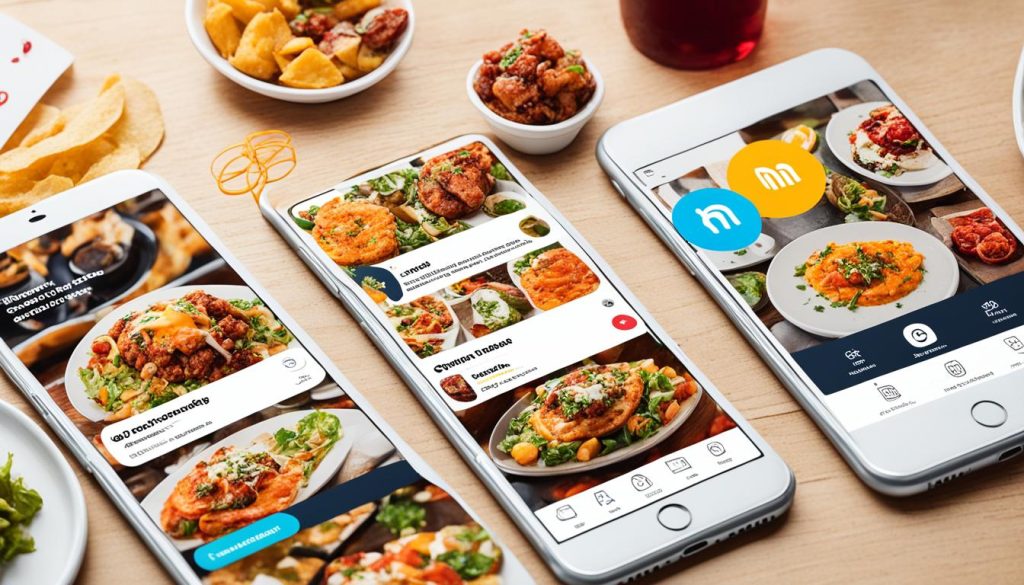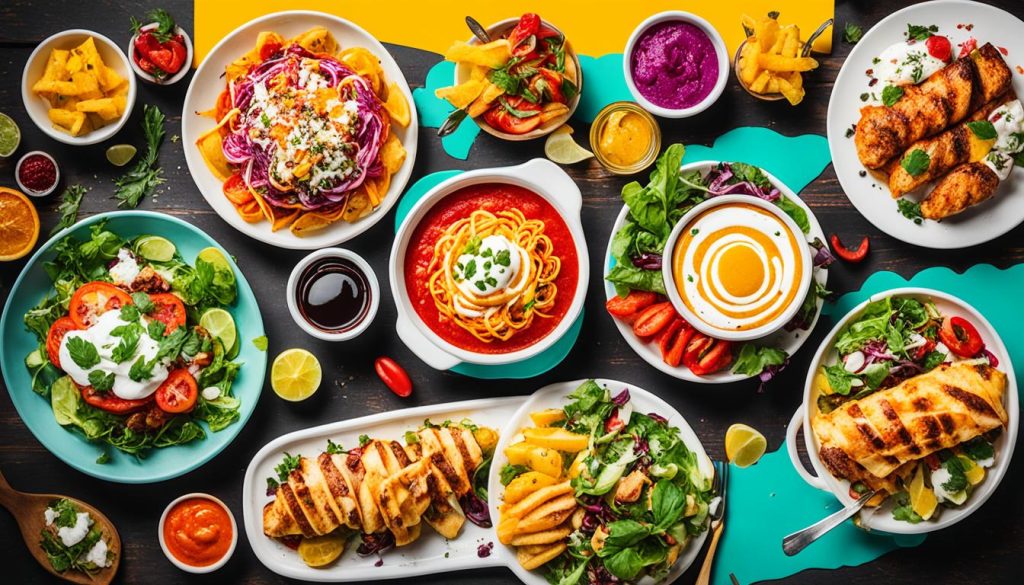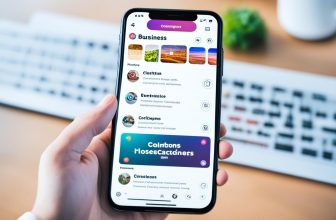The digital era has turned social media into a bustling marketplace of ideas, tastes, and experiences, particularly relevant for the culinary industry. An effective social media strategy has the power to transform the way restaurants connect with their patrons, turning casual browsers into loyal customers. With effective social media strategies for restaurants, the table is set for enticing visuals and compelling stories to capture the hearts and palates of food enthusiasts across the nation.
Indeed, restaurant marketing on social media has become an essential ingredient in the recipe for success. It’s an exceptional platform where savors and services merge, encouraging diners to engage with their favorite eateries. It’s not just about posting a menu or announcing a new dish; it’s about creating a narrative that resonates with the audience, boosting restaurant sales through social media by appealing to the tastes of the digital foodies.
Key Takeaways
- Developing an authentic digital presence on social media can greatly influence diner decisions and increase footfall.
- Creative content can turn viewers into visitors, setting your restaurant apart in a competitive market.
- Understand the power of narratives and aesthetics in driving engagement and, ultimately, sales.
- Staying current with social media trends keeps your restaurant relevant and top of mind among consumers.
- Harnessing the data behind social interactions can fine-tune marketing strategies for maximum impact.
- Investment in social media presence is an investment in your restaurant’s growth and reputation.
Understanding Your Restaurant’s Demographics on Social Media
Maximizing restaurant visibility on social media hinges on an in-depth understanding of who your patrons are and what appeals to them. By tailoring your social media approach to reflect the preferences and experiences of your audience, your restaurant can create a magnetic social presence that both resonates with and expands your customer base.
Defining Your Target Audience for Precise Messaging
Before you can engage your audience, you need to know who they are. Are they millennials with a taste for exotic cuisines or families searching for a cozy meal? Establishing a clear picture of your customer demographic allows for precise messaging that feels personal and relevant. This targeted approach not only captivates but also fosters loyalty among your restaurant’s followers.
Utilizing Analytics for Enhanced Demographic Insights
Modern social media management tools for restaurants offer a wealth of analytics to dissect your following into digestible insights. Age, gender, location, and even the kind of content your customers prefer are just a snapshot of the data available at your fingertips. These insights empower restaurant marketers to fine-tune their strategy, from the tone of voice to visual elements, ensuring that every post has the potential to connect and engage.
By leveraging these analytics, a restaurant can navigate the complex web of customer interactions and preferences to not only be seen but to make a lasting impression. Understanding the nuances of your audience helps to employ social media management for restaurants to its fullest potential — creating content that is as palatable to your customers as your dishes.
| Demographic | Preferred Content | Optimized Platform |
|---|---|---|
| Millennials (25-40) | Behind-the-scenes, Authentic Stories | Instagram, TikTok |
| Gen X (41-56) | Family Deals, Community Events | Facebook, Twitter |
| Baby Boomers (57-75) | Health-focused Menus, Nostalgic Content | Facebook, Pinterest |
This table reflects a simplified glance at how different generations may interact with restaurant content on social media. By mapping out your demographics against their content preferences and optimizing platforms, social media campaigns can be tailored to ensure your restaurant is not just present but truly seen and remembered.
Building a Solid Social Media Foundation
A robust online presence on social networks can be a main ingredient in successful social media campaigns for restaurants. It’s essential to begin with the basics, carefully laying down the infrastructure that will support all other marketing efforts on these platforms. An effective social media management for restaurants involves a meticulous approach to profile creation and maintenance, ensuring a unified presence that customers can easily recognize and trust.

Consistency Across Profiles: The Key to Brand Recognition
To forge a connection with your audience, every touchpoint on social media must be in harmony. That means your restaurant’s name should be uniform across platforms, your handles should be recognizable, and your profile photos should be iconic representations of your brand. This symmetry aids in establishing strong brand recall, which is crucial for customer loyalty and patronage.
Optimizing Social Media Bios for Greater Visibility
Don’t overlook the significance of your social media bios. A captivating bio serves as an open invitation to prospective diners. It should contain succinct yet comprehensive information, including your restaurant’s location, a link to the website, and a few words that encapsulate your brand’s ethos. An optimized bio not only conveys essential details but also enhances your restaurant’s discoverability on social media platforms, inviting patrons to explore and engage with your brand.
Engaging Customers with Creative Social Media Content
To implement effective social media strategies for restaurants, it’s essential to develop content that resonates with your audience. Boosting restaurant sales through social media hinges on your restaurant’s ability to engage customers with creative posts and unique interactions. Here are some methods that have proven successful on popular social media channels for restaurants:
- Hold themed contests, especially on platforms like Instagram, to spark excitement and participation.
- Encourage the sharing of user-generated content to build community and authenticity.
- Coordinate social media account takeovers with local food influencers to provide fresh perspectives.
- Maintain a robust posting schedule to keep your brand top-of-mind with frequent, quality content.
- Deploy employee spotlights to humanize your brand and showcase the people behind the plates.
In addition to these strategies, forging a distinct brand voice and visual style is critical in setting your restaurant apart from the competition.

When creating content for your social media channels, variety keeps your feed dynamic and engaging. A mix of the types of content you post can help to attract and retain a varied audience. Here’s an example of a content mix that could be featured throughout the week:
| Day of the Week | Content Type | Objective |
|---|---|---|
| Monday | Daily Specials Announcement | To inform customers of unique offers and drive sales. |
| Wednesday | Behind-the-Scenes Photos | To connect customers with the culinary process and build authenticity. |
| Friday | Customer Testimonials | To provide social proof and entice new customers to visit your restaurant. |
| Saturday | Live Music Event Promotion | To create buzz and encourage customers to dine during entertainment nights. |
| Sunday | Community Event Highlights | To showcase involvement in local events and foster community support. |
By presenting a variety of content, from mouth-watering food imagery to highlighting the team that makes your restaurant special, you cultivate an online environment that mirrors the welcoming atmosphere of your establishment. Remember, the goal is to craft a digital space where engagement flourishes and online interactions translate into in-store dining experiences.
“Engagement breeds familiarity, and familiarity breeds trust. When customers trust your restaurant, they’re more likely to become repeat patrons and share their experiences with others.”
Best Social Media for Restaurants – Choosing the Right Platforms
In today’s digital era, restaurant marketing on social media is not just about posting regular updates; it’s about strategic channel selection and content customization to maximize engagement and exposure. Choosing the top social media platforms for restaurants entails a deep understanding of each platform’s unique offerings and demographic strengths.
Top Social Media Platforms for Maximum Restaurant Exposure
For restaurateurs aiming to captivate a broad audience, considering the giants of social media is a great starting point. Facebook continues to be a versatile platform for sharing a blend of casual updates, detailed posts, and events. Instagram, with its visual-centric approach, is ideal for showcasing the restaurant’s ambiance and mouth-watering dishes. Meanwhile, TikTok has emerged as a hub for creativity, perfect for viral marketing campaigns with its younger demographic skew.
Aligning Social Media Channels with Restaurant Marketing Goals
The efficacy of each social media channel aligns with how well it serves the restaurant’s marketing goals. Whether the goal is to build brand awareness, foster a community, or drive sales with promotions, aligning the platform’s strengths to these objectives is crucial. Insightful content tailored for a restaurant’s preferred customer base on the primary platform, complemented by cross-promotion on secondary channels, can lead to a comprehensive and effective online presence.
- Facebook: For broad demographic reach and community building through events and reviews.
- Instagram: To captivate users with stunning food visuals and stories.
- TikTok: For engaging a younger audience with trending challenges and dynamic content.
By understanding the nuances of these platforms and leveraging their specific features, restaurants can craft an enviable social media identity. Notably, focusing on high-quality imagery and investing in video content can significantly enhance a restaurant’s appeal, driving engagement and potential patronage.
Leveraging User-Generated Content to Boost Reputation
To maximize restaurant visibility on social media, savvy business owners are turning to user-generated content (UGC) for its authentic appeal and power to connect with customers. This type of content, forged from the experiences and perspectives of diners themselves, not only helps establish credibility but also intimately showcases the dining experience through the eyes of guests.
In the realm of social media management for restaurants, it’s critical to foster an environment where patrons are motivated to share their visits. Encouraging customers to post pictures of their favorite dishes or celebrate special occasions at your venue can trigger a domino effect of visibility. Capturing moments such as a toast with a signature cocktail or the excitement of trying a new seasonal menu can act as powerful endorsements for your establishment.
- Creating a unique hashtag for your restaurant to streamline content discovery
- Featuring a “customer of the week” post acknowledging great pictures or reviews
- Setting up visually appealing spots in your restaurant for the perfect Instagram photo-op
Incorporating Customer Content in Your Strategy
User-generated content can be a goldmine for your social media strategy, substantially maximizing your online presence. It’s not just about reposting customer stories and photos, but also about integrating this content to reflect community involvement and appreciation. For instance, a gallery of UCG on your website or a live social media feed display in your restaurant can add dimension to your brand’s story and digital footprint.
Below are some practical ways to make UGC work for you:
- Request permission to share customers’ content on your profiles and give credit.
- Promote user content to highlight genuine testimonials which new visitors immensely trust.
- Share behind-the-scenes glimpses into the kitchen or event prep to engage users with day-to-day operations.
By embracing user-generated content as a pillar of your social media management, restaurants can not only increase their visibility on social media but also create an inclusive and appealing online community. Remember, each post shared by your customers extends your reach to potential patrons within their networks, amplifying your social media impact organically.
Incorporating Video Content for Impactful Storytelling
As digital platforms evolve, so does the landscape of marketing for the culinary world. Today, the most successful social media campaigns for restaurants are embracing video content to tell their stories and connect with food enthusiasts. Notably, short, snappy vertical videos have taken the lead in captivating audiences across popular social media channels for restaurants, such as TikTok and Instagram Reels.
To create memorable and engaging content, restaurants are utilizing specific strategies that compliment the fast-paced, visually-oriented nature of these platforms. Let’s break down the essential ingredients for crafting video content that resonates with your dining audience.
- Hook Your Audience Immediately: Your video’s opening moments are crucial. Make them count with an intriguing start that promises something worth watching.
- Natural Light for Natural Appetite: Shooting your video in natural light can greatly enhance the appeal of your dishes, making them look even more delicious.
- Stability is Key: Use tripods or other stabilizing equipment to ensure your videos come out clear and professional, avoiding unappetizing shaky camerawork.
- Showcase Your Personality: Let viewers get to know not just your food, but the unique character of your restaurant. Whether it’s your lively staff or cozy decor, give them a taste of your atmosphere.
Incorporating these elements into your video content can greatly amplify the connection between potential patrons and your dining establishment, urging them to turn from viewers into visitors. Personal interactions and responses to community activity are invaluable, making followers feel at home even before they walk through your doors.
| Video Element | Benefit |
|---|---|
| Engaging Hooks | Captures attention, reduces scroll-past rates |
| Natural Lighting | Improves aesthetic, makes food more enticing |
| Stable Footage | Increases professionalism, improves viewer experience |
| Brand Personality | Builds relationship with audience, differentiates from competition |
Remember, these strategies are not just for one-off videos; consistency matters. Establishing a series or theme can provide an ongoing narrative for your followers to return to, fostering a continuous and deepening bond with the community. Strike a balance between quality content and regular uploads to keep your restaurant top-of-mind and a frequent talking point among your customer base.
“Storytelling is the most powerful way to put ideas into the world today.” — Robert McKee
Video storytelling isn’t just a passing trend; it’s a profound way to engage your audience and empower your brand within the dynamic space of food marketing. By recognizing the synergy between delicious cuisine and captivating video content, restaurants can curate an unforgettable social media presence that leaves viewers hungry for more.
Conclusion
As the digital dining table extends its reach through social media, restaurants stand at the precipice of marketing innovation, where success is not just measured by the aroma of the dishes served but by the digital footprint they leave behind. Effective social media management for restaurants plays a pivotal role in this arena, substantiated by the palpable metrics that track engagement. These numbers narrate the story of how content resonates with audiences, signaling which posts serve as the main course and which are merely appetizers. By scrutinizing direct messages, reposts, comments, and overall user interaction, restaurateurs can garnish their strategies with insights drawn from real-time customer feedback.
Tracking Social Media Success Through Engagement Metrics
Monitoring these metrics transcends mere vanity; it provides substance for shaping the future course of restaurant marketing on social media. Understanding what captivates guests allows for a more immersive and satisfying virtual experience, akin to the contentment of a perfectly curated meal. The goal is simple yet strategic: to not only engage customers but to transform their virtual interactions into tangible footfall, bringing the ambience of the online community into the cozy booths of their local eateries. Engagement metrics are the compass by which this journey is navigated, guiding the way to a more connected culinary experience.
Adapting and Evolving Your Social Media Tactics
The culinary world is one of relentless innovation and adaptation; its social media counterpart should follow suit. As tastes evolve and trends mature, so too must the tactics employed by restaurants in the digital realm. Staying fresh, relevant, and effective means regularly seasoning campaigns with novelty, responding deafeningly to consumer trends, and always being prepared to pivot the menu of content to satisfy the diverse palate of the social media audience. It’s an ongoing process, a recipe in constant refinement, aimed at maintaining the savor of success in restaurant sales and customer loyalty through a robust and relatable online presence.
FAQ
Effective strategies include defining your target audience, posting engaging content, utilizing analytics for insights, leveraging user-generated content, and incorporating video for storytelling. Focused efforts on platforms where your audience is most active and consistent brand messaging across profiles are crucial for boosting restaurant sales through social media.
To maximize visibility, optimize your social media profiles with consistent names, attractive bios, and relevant information. Use targeted advertising and analytics to reach your desired audience, and engage users with high-quality, diverse content such as contests, live events, and user-generated posts.
Consistent branding across profiles helps with brand recognition and reinforces your restaurant’s identity. When customers can easily identify your restaurant on various platforms, it increases trust and credibility, which are essential for a successful social media presence.
Knowing your demographics allows you to create precise messaging that resonates with your audience. It guides your content strategy, helps tailor your ads, and ensures more effective engagement. Analytics tools can provide demographic insights, such as age groups and location, enhancing your marketing efforts.
The best platforms for restaurant marketing often include Facebook, Instagram, and TikTok. The choice depends on where your target audience is most active and the type of content that best showcases your restaurant. Each platform has its strengths and caters to different demographics and content styles.
How can I use user-generated content to promote my restaurant?
Encourage customers to share their dining experiences on social media by creating a shareable atmosphere, offering incentives for posting, and sharing their content (with permission) on your profiles. User-generated content provides social proof and authentic testimonials that can attract new customers.
What are some tips for creating successful video content for my restaurant?
For successful video content, focus on making the first few seconds captivating, using good lighting, ensuring stable video quality, and showcasing your restaurant’s unique personality. Consider creating a series of videos for consistency and encourage viewer interaction with your content.
Track the success of your campaigns through engagement metrics such as likes, comments, shares, and direct messages. Monitor changes in follower count and analyze which types of content generate the most engagement. Use these insights to adapt and evolve your social media tactics to maintain relevance and effectiveness.







